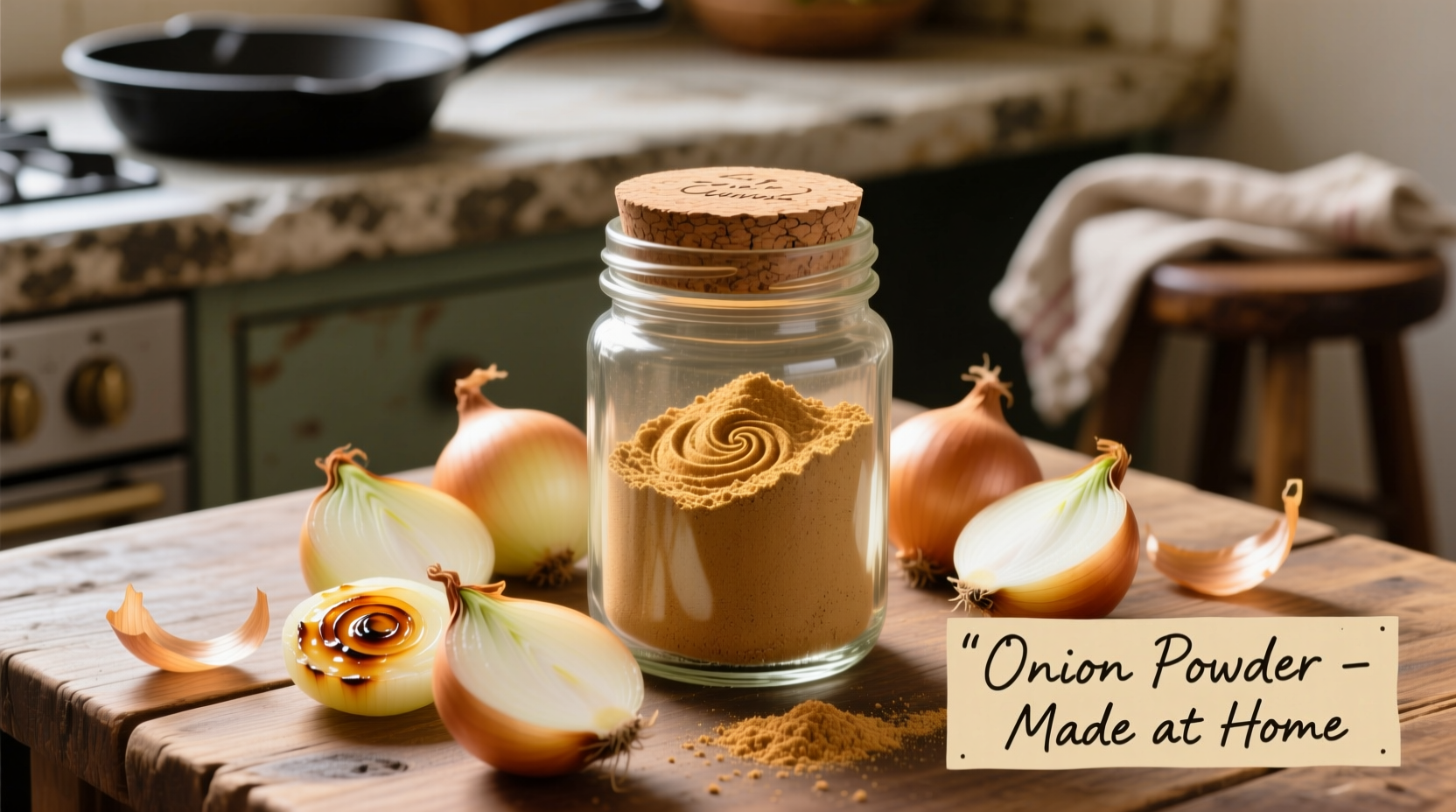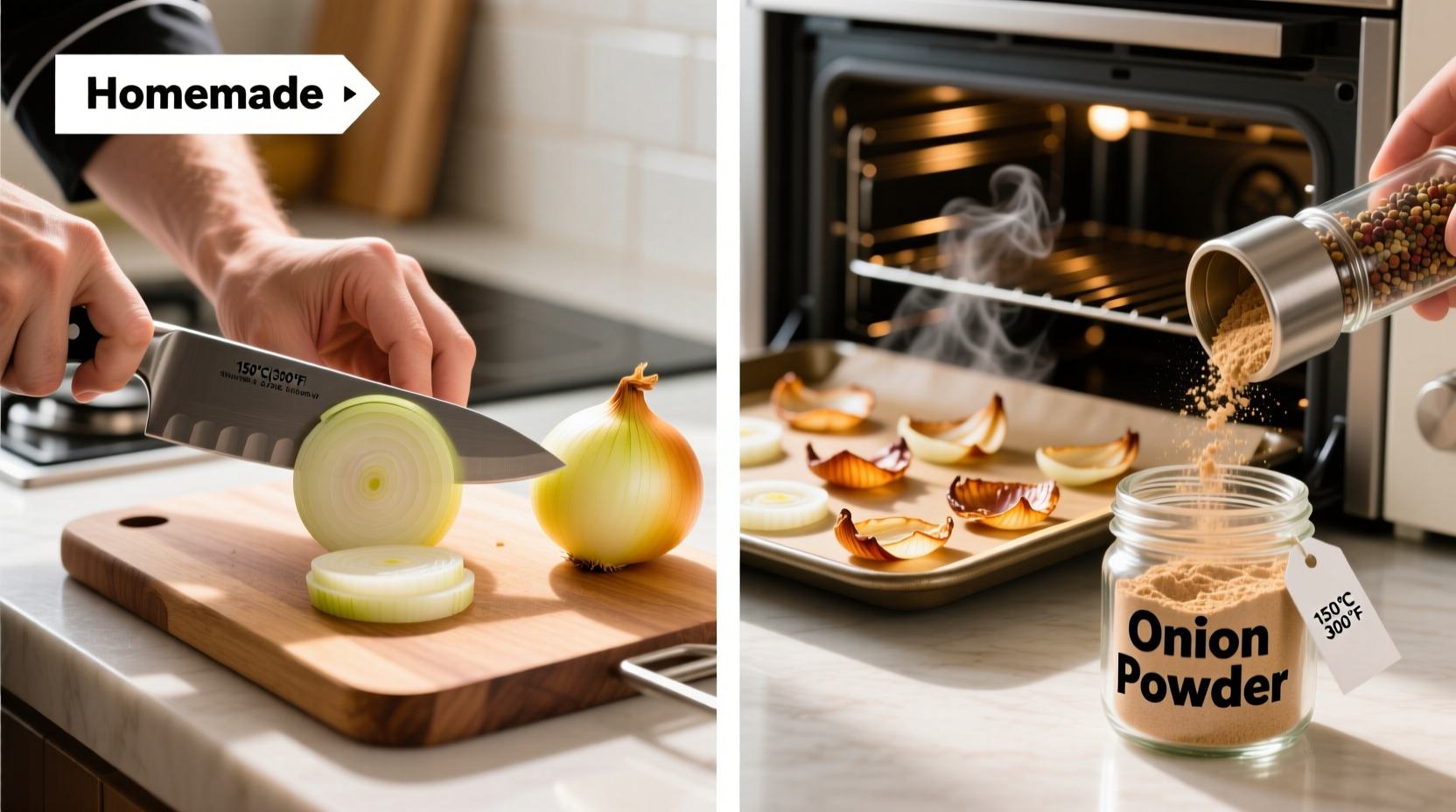Make professional-quality onion powder at home in just 4 steps: slice onions thinly, dehydrate at 135°F (57°C) for 6-10 hours until brittle, grind to fine powder, and store in airtight containers. Homemade onion powder costs 60% less than store-bought versions and contains no additives while delivering fresher, more vibrant flavor.
Creating your own onion powder transforms ordinary cooking with intense, pure onion flavor without preservatives or anti-caking agents. As a professional chef who's taught thousands of home cooks spice techniques, I've found that homemade onion powder elevates dishes with a depth of flavor commercial products simply can't match. The process takes minimal active time but delivers exceptional results that will change how you approach everyday cooking.
Essential Equipment Checklist
Before starting, gather these kitchen essentials:
- Sharp chef's knife or mandoline slicer (1/8-inch thickness)
- Dehydrator (preferred) or conventional oven
- High-speed blender or spice grinder
- Fine mesh sieve (80-100 micron)
- Airtight glass containers for storage
| Method | Time Required | Energy Cost | Flavor Quality |
|---|---|---|---|
| Dehydrator | 6-10 hours | $0.25-0.50 | Excellent (preserves volatile compounds) |
| Oven Method | 4-6 hours | $0.75-1.25 | Good (some flavor loss at higher temps) |
| Sun Drying | 2-3 days | $0.00 | Fair (inconsistent results) |
Step-by-Step Preparation Process
1. Selecting and Preparing Onions
Yellow onions provide the most versatile flavor profile, though red onions offer slightly sweeter notes. Avoid sweet varieties like Vidalia for powder production as they contain more moisture. According to USDA food preservation guidelines, onions should be firm with no sprouting. Peel and slice uniformly to 1/8-inch thickness using a mandoline for consistent results. Thinner slices dry faster but risk burning; thicker slices retain moisture that causes spoilage.

2. Dehydration Techniques Compared
Dehydrator method (recommended): Arrange slices in single layer on trays. Set temperature to 135°F (57°C) for 6-10 hours until completely brittle. Rotate trays hourly for even drying. This low-temperature method preserves the maximum amount of flavor compounds according to research from the National Center for Home Food Preservation.
Oven method: Place slices on parchment-lined baking sheets. Set oven to lowest possible temperature (170°F/77°C) with door slightly ajar using a wooden spoon. Rotate pans every 30 minutes. Total drying time: 4-6 hours. Check frequently to prevent scorching.
3. Grinding to Perfect Consistency
Properly dried onions should snap cleanly when bent. Grind in small batches using a high-speed blender or dedicated spice grinder. Pulse in 30-second intervals to prevent overheating, which degrades flavor compounds. Pass through a fine mesh sieve to separate coarse pieces for regrinding. The ideal particle size for onion powder is 80-100 microns – fine enough to dissolve completely in liquids.
4. Storage for Maximum Shelf Life
Store in airtight amber glass containers away from light and heat. Properly stored homemade onion powder maintains peak flavor for 6-8 months, compared to 3-4 months for commercial products according to FDA food storage guidelines. Add 1-2 silica gel packets to absorb residual moisture. Never store in plastic containers as onions can impart flavor to the plastic.
When Homemade Outperforms Store-Bought
While commercial onion powder serves its purpose, homemade versions shine in specific culinary applications. Professional chefs consistently prefer homemade powder for delicate sauces, clear soups, and dishes where texture matters. The absence of anti-caking agents (common in commercial products) allows for smoother integration into liquids. Additionally, you control the sodium content – crucial for those managing dietary restrictions.
Troubleshooting Common Issues
- Clumping powder: Indicates residual moisture. Return to dehydrator for additional 2 hours.
- Muted flavor: Over-drying or excessive heat during dehydration. Reduce temperature next batch.
- Bitter taste: Onion slices too thin or burned during drying. Use thicker slices next time.
- Short shelf life: Inadequate drying or improper storage. Check moisture content with silica test packet.
Professional Usage Tips
Reconstitute powder with 2 parts water for instant onion paste in recipes. For enhanced flavor, toast powder in dry skillet for 30 seconds before use – this activates additional flavor compounds through the Maillard reaction. When substituting for fresh onions, use 1 tablespoon powder per medium onion, but reduce liquid in recipe by 2 tablespoons.
Frequently Asked Questions
Can I make onion powder without a dehydrator?
Yes, you can use your oven's lowest setting (170°F/77°C) with the door slightly ajar. Spread onion slices on parchment-lined baking sheets and rotate every 30 minutes for 4-6 hours until completely brittle. Check frequently to prevent burning, as oven temperatures can fluctuate.
How do I know when onions are properly dehydrated?
Properly dehydrated onions should snap cleanly when bent, not bend or crumble. They should feel completely dry with no moisture when broken. If any flexibility remains, continue drying for another hour and retest. The National Center for Home Food Preservation recommends testing multiple pieces from different trays for consistent results.
Does homemade onion powder need preservatives?
No, properly dehydrated onion powder (with moisture content below 10%) doesn't require preservatives. The dehydration process removes sufficient moisture to prevent microbial growth. Store in airtight containers with silica gel packets to maintain dryness. Commercial products often contain anti-caking agents like calcium silicate, which aren't necessary when making small batches for personal use.
What's the best onion variety for powder?
Yellow onions provide the most versatile flavor profile for general cooking. Red onions offer slightly sweeter notes suitable for salsas and dressings. Avoid sweet varieties like Vidalia as their higher moisture content makes dehydration more challenging. For specialized applications, shallots create an elegant powder perfect for delicate sauces and finishing dishes.
How much fresh onion equals one tablespoon of powder?
One medium onion (about 150g) yields approximately 3 tablespoons of powder. When substituting in recipes, use 1 tablespoon powder per medium onion, but reduce liquid content by 2 tablespoons to account for the water that would come from fresh onions. For concentrated flavor in dry rubs, you can use up to 1.5 tablespoons powder per onion equivalent.











 浙公网安备
33010002000092号
浙公网安备
33010002000092号 浙B2-20120091-4
浙B2-20120091-4